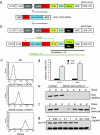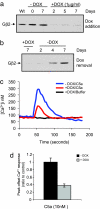A single lentiviral vector platform for microRNA-based conditional RNA interference and coordinated transgene expression
- PMID: 16945906
- PMCID: PMC1557799
- DOI: 10.1073/pnas.0606179103
A single lentiviral vector platform for microRNA-based conditional RNA interference and coordinated transgene expression
Abstract
RNAi is proving to be a powerful experimental tool for the functional annotation of mammalian genomes. The full potential of this technology will be realized through development of approaches permitting regulated manipulation of endogenous gene expression with coordinated reexpression of exogenous transgenes. We describe the development of a lentiviral vector platform, pSLIK (single lentivector for inducible knockdown), which permits tetracycline-regulated expression of microRNA-like short hairpin RNAs from a single viral infection of any naïve cell system. In mouse embryonic fibroblasts, the pSLIK platform was used to conditionally deplete the expression of the heterotrimeric G proteins Galpha12 and Galpha13 both singly and in combination, demonstrating the Galpha13 dependence of serum response element-mediated transcription. In RAW264.7 macrophages, regulated knockdown of Gbeta2 correlated with a reduced Ca(2+) response to C5a. Insertion of a GFP transgene upstream of the Gbeta2 microRNA-like short hairpin RNA allowed concomitant reexpression of a heterologous mRNA during tetracycline-dependent target gene knockdown, significantly enhancing the experimental applicability of the pSLIK system.
Conflict of interest statement
Conflict of interest statement: No conflicts declared.
Figures




References
-
- Elbashir SM, Harborth J, Lendeckel W, Yalcin A, Weber K, Tuschl T. Nature. 2001;411:494–498. - PubMed
-
- Hannon GJ, Rossi JJ. Nature. 2004;431:371–378. - PubMed
-
- Brummelkamp TR, Bernards R, Agami R. Science. 2002;296:550–553. - PubMed
-
- Paul CP, Good PD, Winer I, Engelke DR. Nat Biotechnol. 2002;20:505–508. - PubMed
Publication types
MeSH terms
Substances
Grants and funding
LinkOut - more resources
Full Text Sources
Other Literature Sources
Medical
Research Materials
Miscellaneous

